Designing Teaching Resources for Arts Education in Australia
VerifiedAdded on 2023/04/07
|15
|2240
|74
AI Summary
This article discusses the process of designing teaching resources for arts education in Australia. It explores the connections between topics and resources, and emphasizes the use of technology for effective learning. The target audience is students between 16-25 years of age.
Contribute Materials
Your contribution can guide someone’s learning journey. Share your
documents today.
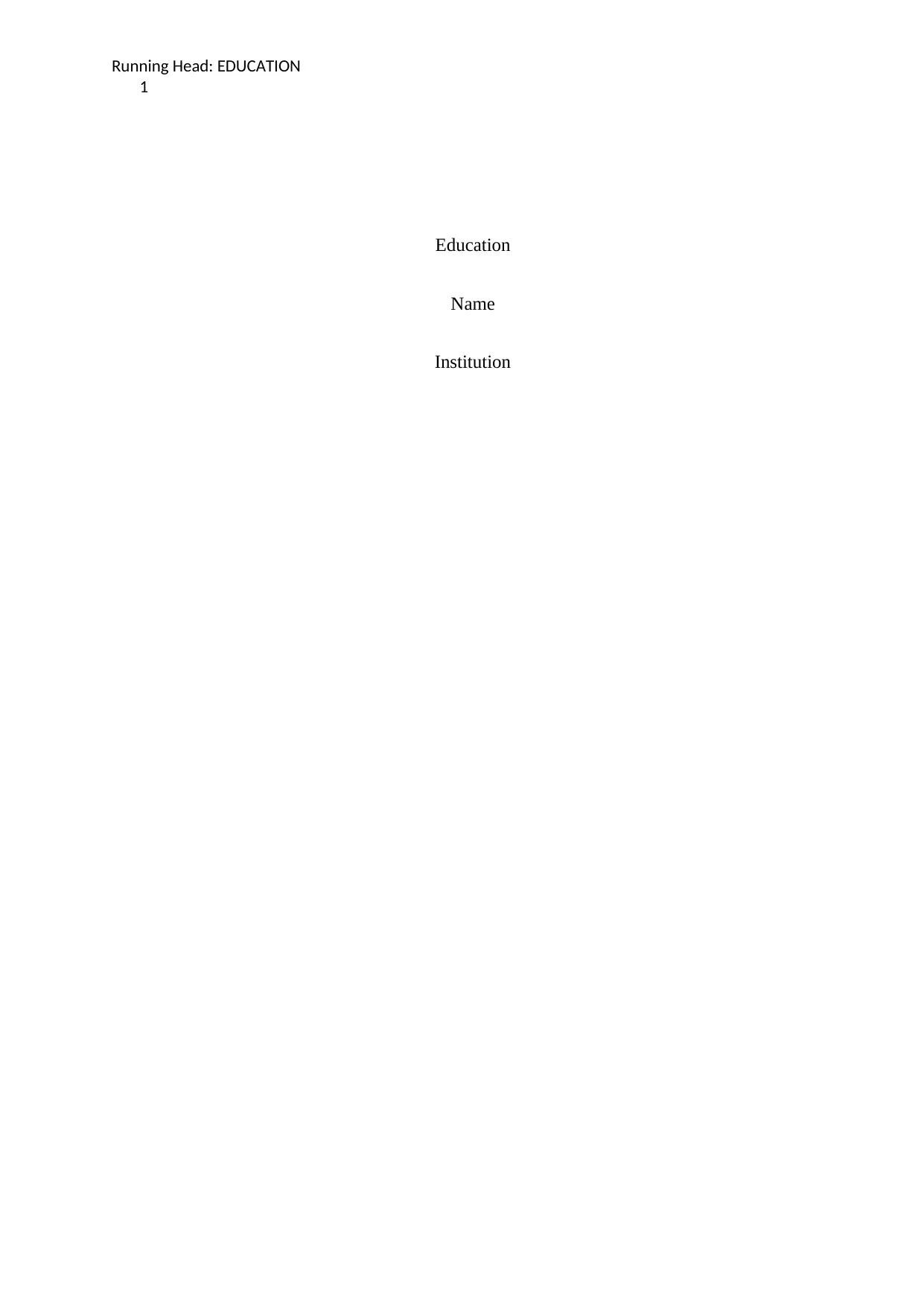
Running Head: EDUCATION
1
Education
Name
Institution
1
Education
Name
Institution
Secure Best Marks with AI Grader
Need help grading? Try our AI Grader for instant feedback on your assignments.

EDUCATION 2
Task 1
Design and justify teaching resources from the topics studied in the unit. Include a
description of the connections between the topics and resources. Be clear about the focus on
the age level targeted.
In designing the teaching resources that shall be used from the topics studied in the unit,
various factors should be taken into consideration. The design should be coherent and
consistent on its layout of the topics. In designing the resources, the connections between the
topics and resources will be clearly established and defined. The design is also set to embrace
technology so as to achieve the best mode of learning. This way the students are able to go
through many topics at the same but on different displays. This helps the students to easily
comprehend what they are taught in class rooms. The design is structured such that it meets
the requirements of Australian curriculum
Teaching resources are tools designed by teachers to help them in conveying and teaching
their lessons. Any tool used in carrying information to test understanding is a teaching tool.
The lesson is about Arts in Australia. An art heightens the ability of students to imagine, this
encourages them to create and express their potential. In Australia, there are five art subjects:
media, drama, music, visual art and dance. These together provide students with great
opportunities to learn, create, communicate, share and represent their concepts and
imagination in a well-articulated manner. The art education in Australia targets students
between 16-25 years of age.
At the end of the Arts lesson, students should be able to state his/her role in art education,
know more about arts, be creative, think critically especially where art is involved,
understand and be able to respond with confidence and self-assurance to questions that
involves art. They should be able to share their art ideas through communicating, designing,
Task 1
Design and justify teaching resources from the topics studied in the unit. Include a
description of the connections between the topics and resources. Be clear about the focus on
the age level targeted.
In designing the teaching resources that shall be used from the topics studied in the unit,
various factors should be taken into consideration. The design should be coherent and
consistent on its layout of the topics. In designing the resources, the connections between the
topics and resources will be clearly established and defined. The design is also set to embrace
technology so as to achieve the best mode of learning. This way the students are able to go
through many topics at the same but on different displays. This helps the students to easily
comprehend what they are taught in class rooms. The design is structured such that it meets
the requirements of Australian curriculum
Teaching resources are tools designed by teachers to help them in conveying and teaching
their lessons. Any tool used in carrying information to test understanding is a teaching tool.
The lesson is about Arts in Australia. An art heightens the ability of students to imagine, this
encourages them to create and express their potential. In Australia, there are five art subjects:
media, drama, music, visual art and dance. These together provide students with great
opportunities to learn, create, communicate, share and represent their concepts and
imagination in a well-articulated manner. The art education in Australia targets students
between 16-25 years of age.
At the end of the Arts lesson, students should be able to state his/her role in art education,
know more about arts, be creative, think critically especially where art is involved,
understand and be able to respond with confidence and self-assurance to questions that
involves art. They should be able to share their art ideas through communicating, designing,

EDUCATION 3
observing and expressing their art ideas with others in an organized, meaningful way. They
should understand the local, regional and global cultures, history and traditions through
engaging with the locals and other artist. The students should understand the Australia history
and traditions in arts this is likely by coming into contact with the traditional and current art
of Aboriginal and Torres Strait islander people.
Teaching resources are tools designed by teachers to assist them in delivering and teaching
their lessons. Any tool used in conveying information to test understanding is a teaching tool.
The lesson is about Arts in Australia. An art heightens the ability of students to imagine, this
encourages them to create and express their potential. In Australia, there are five art subjects:
visual art, drama, music, media and dance. These together provide students with great
opportunities to learn, create design, communicate, share and represent their concepts and
imagination in a well formulated manner. The art education in Australia targets students from
foundation to 20 years of age.
At the end of the Arts lesson, students should be able to state his/her role in art education,
know more about arts, be creative, think critically especially where art is involved,
understand and be able to respond with confidence and self-assurance to questions that
involves art. The students should understand the Australia history and traditions in arts this is
possible by coming into contact with the traditional and contemporary art of Aboriginal and
Torres Strait islander people.
Since Australian curriculum sets high standards for what young Australians should learn
from foundation to year 12 then we know what type of audience we are targeting. Our
audiences are students aged 4-20 years of age. From age 4-10 are young people who are still
very naive about the sociology occurrences and are easy to please and entertain when
teaching them, but from age 11-20 years are youth young adults and factors like race, gender,
observing and expressing their art ideas with others in an organized, meaningful way. They
should understand the local, regional and global cultures, history and traditions through
engaging with the locals and other artist. The students should understand the Australia history
and traditions in arts this is likely by coming into contact with the traditional and current art
of Aboriginal and Torres Strait islander people.
Teaching resources are tools designed by teachers to assist them in delivering and teaching
their lessons. Any tool used in conveying information to test understanding is a teaching tool.
The lesson is about Arts in Australia. An art heightens the ability of students to imagine, this
encourages them to create and express their potential. In Australia, there are five art subjects:
visual art, drama, music, media and dance. These together provide students with great
opportunities to learn, create design, communicate, share and represent their concepts and
imagination in a well formulated manner. The art education in Australia targets students from
foundation to 20 years of age.
At the end of the Arts lesson, students should be able to state his/her role in art education,
know more about arts, be creative, think critically especially where art is involved,
understand and be able to respond with confidence and self-assurance to questions that
involves art. The students should understand the Australia history and traditions in arts this is
possible by coming into contact with the traditional and contemporary art of Aboriginal and
Torres Strait islander people.
Since Australian curriculum sets high standards for what young Australians should learn
from foundation to year 12 then we know what type of audience we are targeting. Our
audiences are students aged 4-20 years of age. From age 4-10 are young people who are still
very naive about the sociology occurrences and are easy to please and entertain when
teaching them, but from age 11-20 years are youth young adults and factors like race, gender,
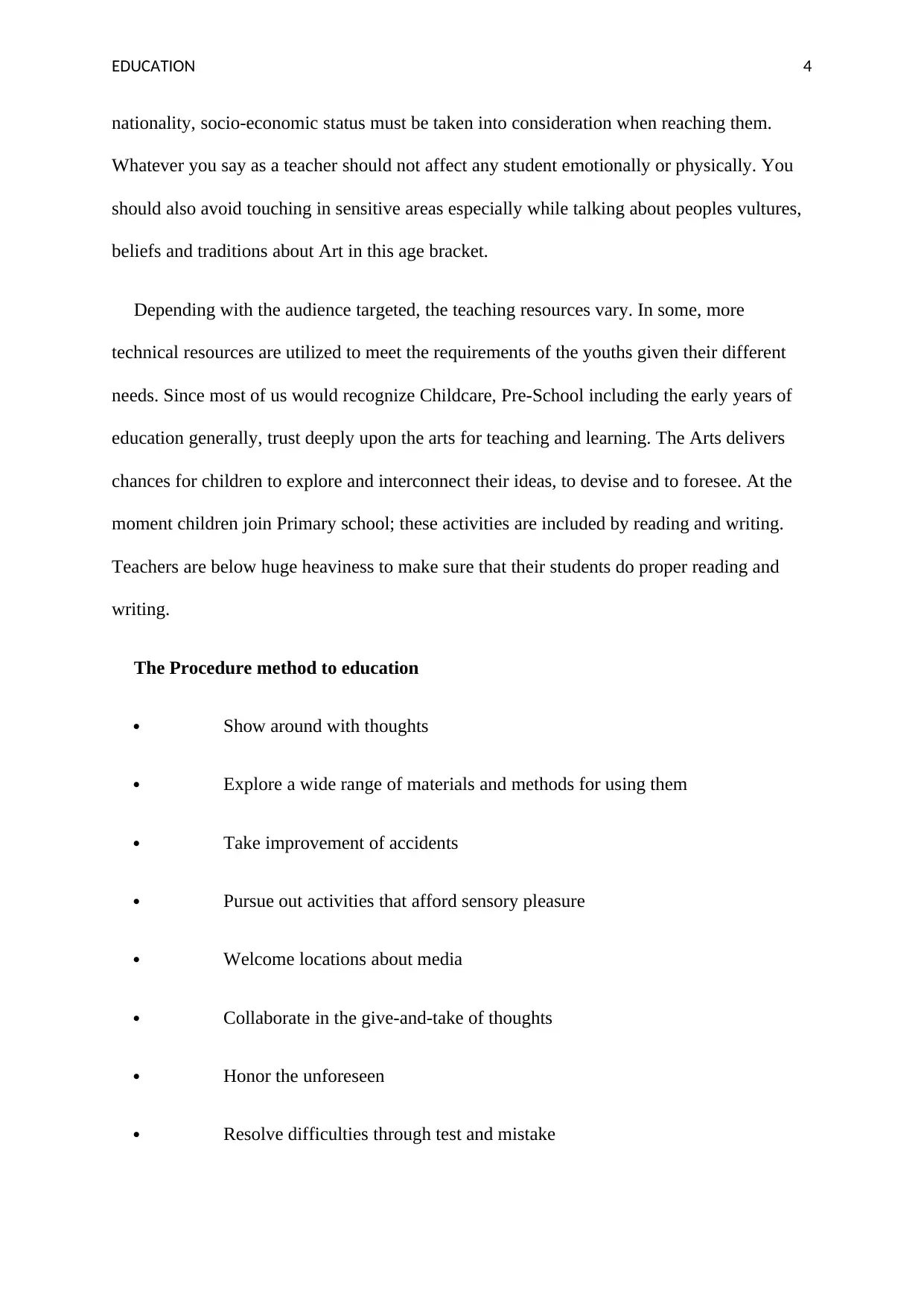
EDUCATION 4
nationality, socio-economic status must be taken into consideration when reaching them.
Whatever you say as a teacher should not affect any student emotionally or physically. You
should also avoid touching in sensitive areas especially while talking about peoples vultures,
beliefs and traditions about Art in this age bracket.
Depending with the audience targeted, the teaching resources vary. In some, more
technical resources are utilized to meet the requirements of the youths given their different
needs. Since most of us would recognize Childcare, Pre-School including the early years of
education generally, trust deeply upon the arts for teaching and learning. The Arts delivers
chances for children to explore and interconnect their ideas, to devise and to foresee. At the
moment children join Primary school; these activities are included by reading and writing.
Teachers are below huge heaviness to make sure that their students do proper reading and
writing.
The Procedure method to education
Show around with thoughts
Explore a wide range of materials and methods for using them
Take improvement of accidents
Pursue out activities that afford sensory pleasure
Welcome locations about media
Collaborate in the give-and-take of thoughts
Honor the unforeseen
Resolve difficulties through test and mistake
nationality, socio-economic status must be taken into consideration when reaching them.
Whatever you say as a teacher should not affect any student emotionally or physically. You
should also avoid touching in sensitive areas especially while talking about peoples vultures,
beliefs and traditions about Art in this age bracket.
Depending with the audience targeted, the teaching resources vary. In some, more
technical resources are utilized to meet the requirements of the youths given their different
needs. Since most of us would recognize Childcare, Pre-School including the early years of
education generally, trust deeply upon the arts for teaching and learning. The Arts delivers
chances for children to explore and interconnect their ideas, to devise and to foresee. At the
moment children join Primary school; these activities are included by reading and writing.
Teachers are below huge heaviness to make sure that their students do proper reading and
writing.
The Procedure method to education
Show around with thoughts
Explore a wide range of materials and methods for using them
Take improvement of accidents
Pursue out activities that afford sensory pleasure
Welcome locations about media
Collaborate in the give-and-take of thoughts
Honor the unforeseen
Resolve difficulties through test and mistake
Paraphrase This Document
Need a fresh take? Get an instant paraphrase of this document with our AI Paraphraser
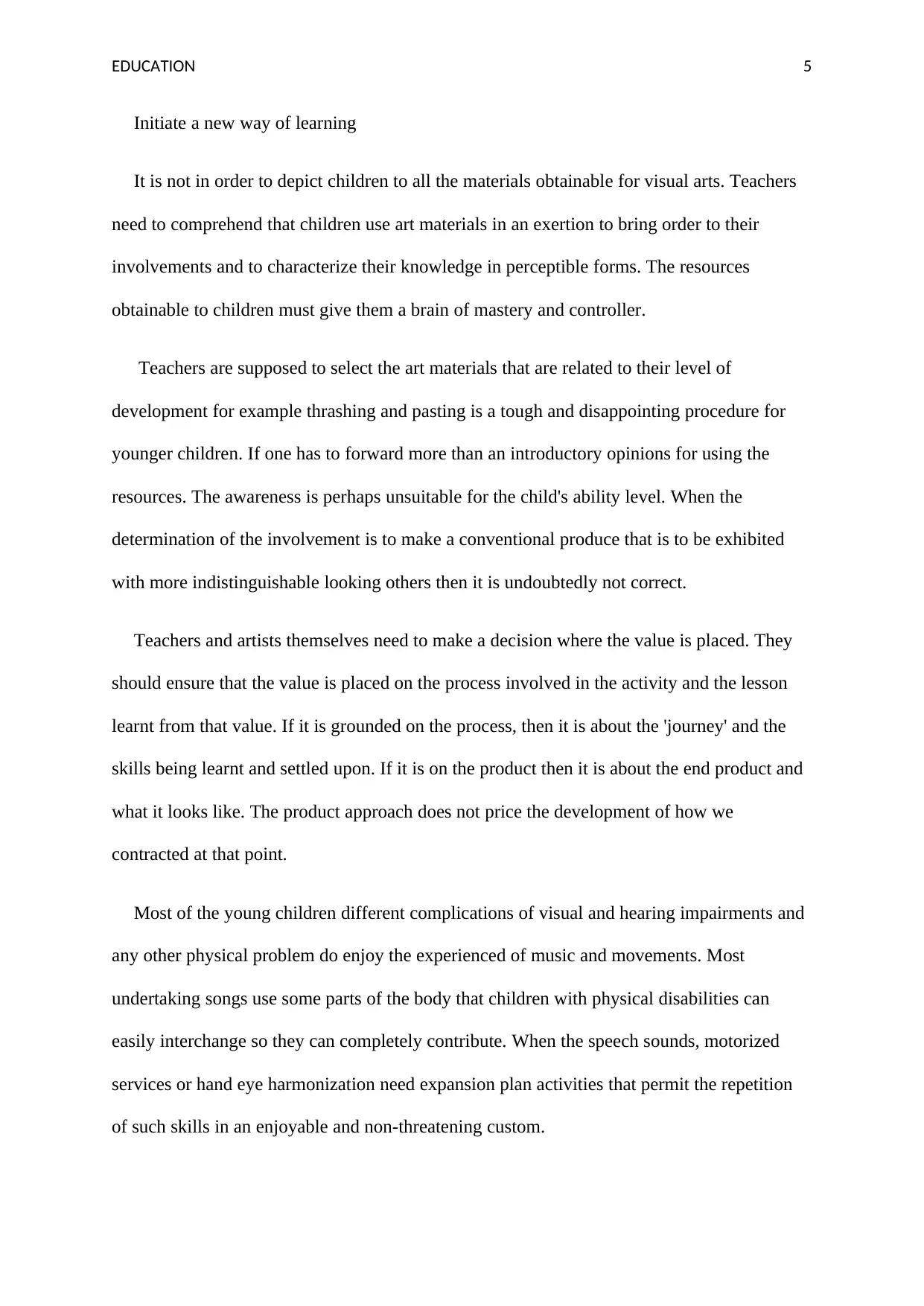
EDUCATION 5
Initiate a new way of learning
It is not in order to depict children to all the materials obtainable for visual arts. Teachers
need to comprehend that children use art materials in an exertion to bring order to their
involvements and to characterize their knowledge in perceptible forms. The resources
obtainable to children must give them a brain of mastery and controller.
Teachers are supposed to select the art materials that are related to their level of
development for example thrashing and pasting is a tough and disappointing procedure for
younger children. If one has to forward more than an introductory opinions for using the
resources. The awareness is perhaps unsuitable for the child's ability level. When the
determination of the involvement is to make a conventional produce that is to be exhibited
with more indistinguishable looking others then it is undoubtedly not correct.
Teachers and artists themselves need to make a decision where the value is placed. They
should ensure that the value is placed on the process involved in the activity and the lesson
learnt from that value. If it is grounded on the process, then it is about the 'journey' and the
skills being learnt and settled upon. If it is on the product then it is about the end product and
what it looks like. The product approach does not price the development of how we
contracted at that point.
Most of the young children different complications of visual and hearing impairments and
any other physical problem do enjoy the experienced of music and movements. Most
undertaking songs use some parts of the body that children with physical disabilities can
easily interchange so they can completely contribute. When the speech sounds, motorized
services or hand eye harmonization need expansion plan activities that permit the repetition
of such skills in an enjoyable and non-threatening custom.
Initiate a new way of learning
It is not in order to depict children to all the materials obtainable for visual arts. Teachers
need to comprehend that children use art materials in an exertion to bring order to their
involvements and to characterize their knowledge in perceptible forms. The resources
obtainable to children must give them a brain of mastery and controller.
Teachers are supposed to select the art materials that are related to their level of
development for example thrashing and pasting is a tough and disappointing procedure for
younger children. If one has to forward more than an introductory opinions for using the
resources. The awareness is perhaps unsuitable for the child's ability level. When the
determination of the involvement is to make a conventional produce that is to be exhibited
with more indistinguishable looking others then it is undoubtedly not correct.
Teachers and artists themselves need to make a decision where the value is placed. They
should ensure that the value is placed on the process involved in the activity and the lesson
learnt from that value. If it is grounded on the process, then it is about the 'journey' and the
skills being learnt and settled upon. If it is on the product then it is about the end product and
what it looks like. The product approach does not price the development of how we
contracted at that point.
Most of the young children different complications of visual and hearing impairments and
any other physical problem do enjoy the experienced of music and movements. Most
undertaking songs use some parts of the body that children with physical disabilities can
easily interchange so they can completely contribute. When the speech sounds, motorized
services or hand eye harmonization need expansion plan activities that permit the repetition
of such skills in an enjoyable and non-threatening custom.
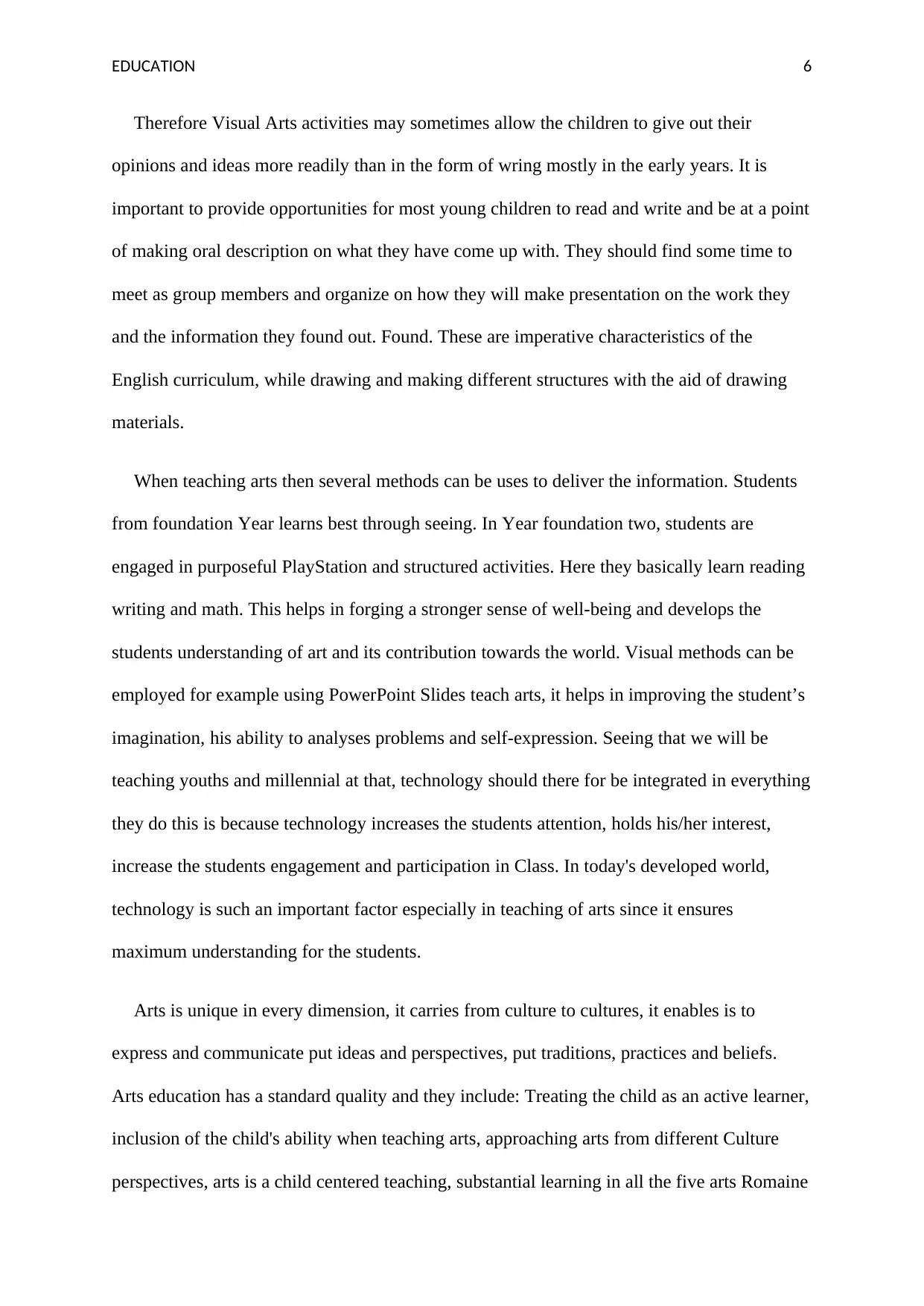
EDUCATION 6
Therefore Visual Arts activities may sometimes allow the children to give out their
opinions and ideas more readily than in the form of wring mostly in the early years. It is
important to provide opportunities for most young children to read and write and be at a point
of making oral description on what they have come up with. They should find some time to
meet as group members and organize on how they will make presentation on the work they
and the information they found out. Found. These are imperative characteristics of the
English curriculum, while drawing and making different structures with the aid of drawing
materials.
When teaching arts then several methods can be uses to deliver the information. Students
from foundation Year learns best through seeing. In Year foundation two, students are
engaged in purposeful PlayStation and structured activities. Here they basically learn reading
writing and math. This helps in forging a stronger sense of well-being and develops the
students understanding of art and its contribution towards the world. Visual methods can be
employed for example using PowerPoint Slides teach arts, it helps in improving the student’s
imagination, his ability to analyses problems and self-expression. Seeing that we will be
teaching youths and millennial at that, technology should there for be integrated in everything
they do this is because technology increases the students attention, holds his/her interest,
increase the students engagement and participation in Class. In today's developed world,
technology is such an important factor especially in teaching of arts since it ensures
maximum understanding for the students.
Arts is unique in every dimension, it carries from culture to cultures, it enables is to
express and communicate put ideas and perspectives, put traditions, practices and beliefs.
Arts education has a standard quality and they include: Treating the child as an active learner,
inclusion of the child's ability when teaching arts, approaching arts from different Culture
perspectives, arts is a child centered teaching, substantial learning in all the five arts Romaine
Therefore Visual Arts activities may sometimes allow the children to give out their
opinions and ideas more readily than in the form of wring mostly in the early years. It is
important to provide opportunities for most young children to read and write and be at a point
of making oral description on what they have come up with. They should find some time to
meet as group members and organize on how they will make presentation on the work they
and the information they found out. Found. These are imperative characteristics of the
English curriculum, while drawing and making different structures with the aid of drawing
materials.
When teaching arts then several methods can be uses to deliver the information. Students
from foundation Year learns best through seeing. In Year foundation two, students are
engaged in purposeful PlayStation and structured activities. Here they basically learn reading
writing and math. This helps in forging a stronger sense of well-being and develops the
students understanding of art and its contribution towards the world. Visual methods can be
employed for example using PowerPoint Slides teach arts, it helps in improving the student’s
imagination, his ability to analyses problems and self-expression. Seeing that we will be
teaching youths and millennial at that, technology should there for be integrated in everything
they do this is because technology increases the students attention, holds his/her interest,
increase the students engagement and participation in Class. In today's developed world,
technology is such an important factor especially in teaching of arts since it ensures
maximum understanding for the students.
Arts is unique in every dimension, it carries from culture to cultures, it enables is to
express and communicate put ideas and perspectives, put traditions, practices and beliefs.
Arts education has a standard quality and they include: Treating the child as an active learner,
inclusion of the child's ability when teaching arts, approaching arts from different Culture
perspectives, arts is a child centered teaching, substantial learning in all the five arts Romaine

EDUCATION 7
of drama, Music, Drama and media.. Substantial learning from Pretoria school and lastly
sequential learning plan to enable growth in arts making and responding to teaching schedule.
The resources therefor that will be uses to teach and deliver this information to the students
for example creating of groups, diagrams, reading and writing, visual method and handing
out of copies to the arts students are relevant and best methods to be uses when teaching of
arts.
The teaching resources are used because they all have different impacts to the students
understanding of arts. They support the objectives of learning arts and are appropriate for the
learning of arts as a subject in Australia. This learning resource ensures that every student
gets out of the learning session with knowledge and understanding about arts development
and cultures of art all Overberg the world. Handouts (printed copies) helps the students with
the literacy and understanding ability because of the questions they contain about arts of
different places in Australia and also the added information in the handouts creates for the
students a wider picture concerning arts.
Group discussion encourages team work among the students, in most cases it is always
fruitful because of the collective ideas gathered concerning arts.it also helps the students to
improve on their communication skills and self-assurance and confidence in themselves is
created. Visual arts improves the students imagination and enhances his thinking capabilities,
it also helps improve a student’s analyzing and presenting skills. Diagrams and drawings
represent structures of the previous arts that existed.
Task 2
Write a justification of how these tasks will meet the requirements for the Australian
and/or State/Territory Curricula, diversity and Aboriginal and Torres Strait Islander people.
of drama, Music, Drama and media.. Substantial learning from Pretoria school and lastly
sequential learning plan to enable growth in arts making and responding to teaching schedule.
The resources therefor that will be uses to teach and deliver this information to the students
for example creating of groups, diagrams, reading and writing, visual method and handing
out of copies to the arts students are relevant and best methods to be uses when teaching of
arts.
The teaching resources are used because they all have different impacts to the students
understanding of arts. They support the objectives of learning arts and are appropriate for the
learning of arts as a subject in Australia. This learning resource ensures that every student
gets out of the learning session with knowledge and understanding about arts development
and cultures of art all Overberg the world. Handouts (printed copies) helps the students with
the literacy and understanding ability because of the questions they contain about arts of
different places in Australia and also the added information in the handouts creates for the
students a wider picture concerning arts.
Group discussion encourages team work among the students, in most cases it is always
fruitful because of the collective ideas gathered concerning arts.it also helps the students to
improve on their communication skills and self-assurance and confidence in themselves is
created. Visual arts improves the students imagination and enhances his thinking capabilities,
it also helps improve a student’s analyzing and presenting skills. Diagrams and drawings
represent structures of the previous arts that existed.
Task 2
Write a justification of how these tasks will meet the requirements for the Australian
and/or State/Territory Curricula, diversity and Aboriginal and Torres Strait Islander people.
Secure Best Marks with AI Grader
Need help grading? Try our AI Grader for instant feedback on your assignments.

EDUCATION 8
This task seeks to show how the resources that are used to teach justify the topics studied
in class. From a different angle, we can look at how this particular justification meets the
needs of Australian people according to their curriculum. It verifies whether such tasks will
improve or change how they live in terms of Australian standards. It also checks whether the
topics studied reflect in the lives of Australians positively or negatively.
For instance, the topic of stages of development in which resources such as module and
lesson plans are utilised to teach the students so as to impact the required knowledge in them
according to Australian policies. This revolves around what actually the task brings to table
in relation to the Australian state. Does the task meet the needs of Torres Strait Islander
people? This type of task help the people realise their potential and learn skills in life
imparted by the resources used by teachers.
The people of Australia and Aboriginal acknowledge and appreciate the value of
education through the resources utilised in class. Visual arts such as ceramics, sculpture,
photography, design, video, film making and architecture are one of the resources used and
this help[s many develop and realise their dream careers. Most of these skills acquired in
class rooms become very useful outside class. Most parents are assured that their children are
taught quality education given the types of resources utilised in studying. Teachers impart
important ideas in students on how to carry out their studies. This brings a positive impact in
the students as they are able to identify their areas of weaknesses and work on them.
Through these resources of learning, the Australian people are able to acquire knowledge
on technology and this helps improve communication in Australia and its constituents.
Further the government is able to recruit more man power and skilled labour given the quality
of resources utilised in class rooms. Most of these classes have embraced the use of
This task seeks to show how the resources that are used to teach justify the topics studied
in class. From a different angle, we can look at how this particular justification meets the
needs of Australian people according to their curriculum. It verifies whether such tasks will
improve or change how they live in terms of Australian standards. It also checks whether the
topics studied reflect in the lives of Australians positively or negatively.
For instance, the topic of stages of development in which resources such as module and
lesson plans are utilised to teach the students so as to impact the required knowledge in them
according to Australian policies. This revolves around what actually the task brings to table
in relation to the Australian state. Does the task meet the needs of Torres Strait Islander
people? This type of task help the people realise their potential and learn skills in life
imparted by the resources used by teachers.
The people of Australia and Aboriginal acknowledge and appreciate the value of
education through the resources utilised in class. Visual arts such as ceramics, sculpture,
photography, design, video, film making and architecture are one of the resources used and
this help[s many develop and realise their dream careers. Most of these skills acquired in
class rooms become very useful outside class. Most parents are assured that their children are
taught quality education given the types of resources utilised in studying. Teachers impart
important ideas in students on how to carry out their studies. This brings a positive impact in
the students as they are able to identify their areas of weaknesses and work on them.
Through these resources of learning, the Australian people are able to acquire knowledge
on technology and this helps improve communication in Australia and its constituents.
Further the government is able to recruit more man power and skilled labour given the quality
of resources utilised in class rooms. Most of these classes have embraced the use of
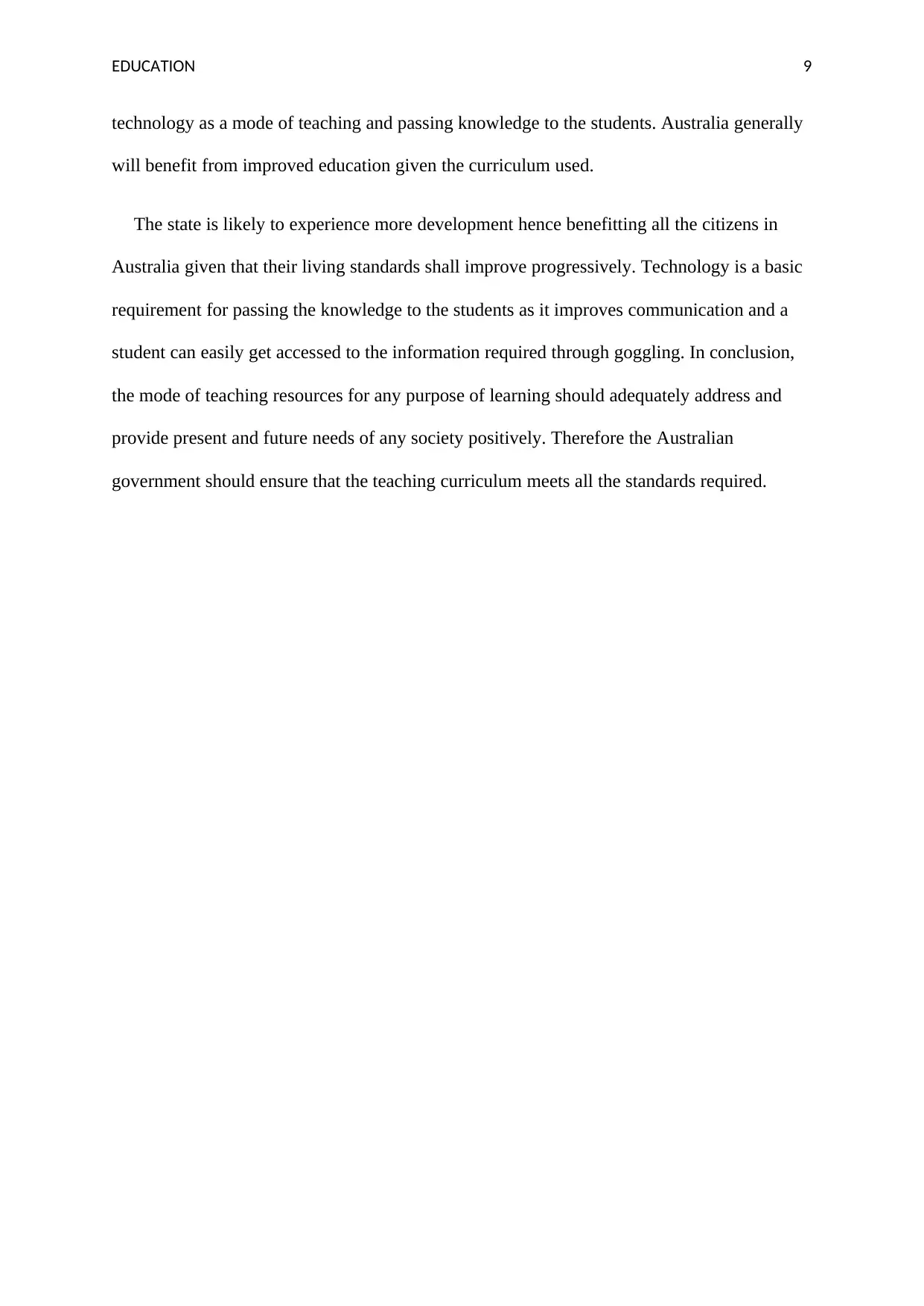
EDUCATION 9
technology as a mode of teaching and passing knowledge to the students. Australia generally
will benefit from improved education given the curriculum used.
The state is likely to experience more development hence benefitting all the citizens in
Australia given that their living standards shall improve progressively. Technology is a basic
requirement for passing the knowledge to the students as it improves communication and a
student can easily get accessed to the information required through goggling. In conclusion,
the mode of teaching resources for any purpose of learning should adequately address and
provide present and future needs of any society positively. Therefore the Australian
government should ensure that the teaching curriculum meets all the standards required.
technology as a mode of teaching and passing knowledge to the students. Australia generally
will benefit from improved education given the curriculum used.
The state is likely to experience more development hence benefitting all the citizens in
Australia given that their living standards shall improve progressively. Technology is a basic
requirement for passing the knowledge to the students as it improves communication and a
student can easily get accessed to the information required through goggling. In conclusion,
the mode of teaching resources for any purpose of learning should adequately address and
provide present and future needs of any society positively. Therefore the Australian
government should ensure that the teaching curriculum meets all the standards required.

EDUCATION 10
Paraphrase This Document
Need a fresh take? Get an instant paraphrase of this document with our AI Paraphraser

EDUCATION 11

EDUCATION 12

EDUCATION 13
Secure Best Marks with AI Grader
Need help grading? Try our AI Grader for instant feedback on your assignments.

EDUCATION 14

EDUCATION 15
1 out of 15
Related Documents
Your All-in-One AI-Powered Toolkit for Academic Success.
+13062052269
info@desklib.com
Available 24*7 on WhatsApp / Email
![[object Object]](/_next/static/media/star-bottom.7253800d.svg)
Unlock your academic potential
© 2024 | Zucol Services PVT LTD | All rights reserved.





